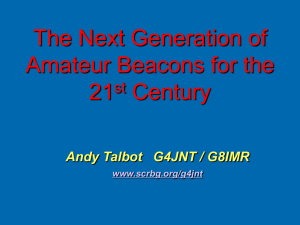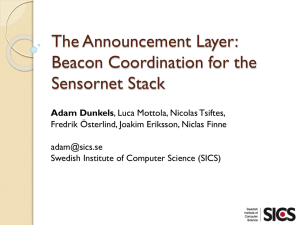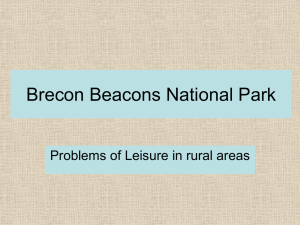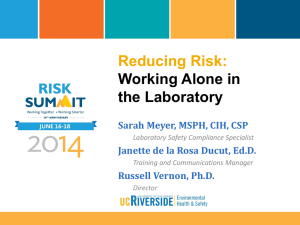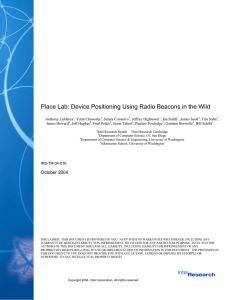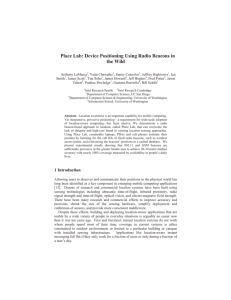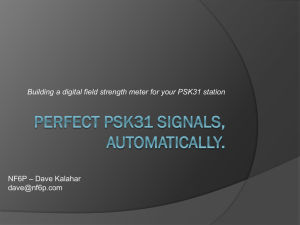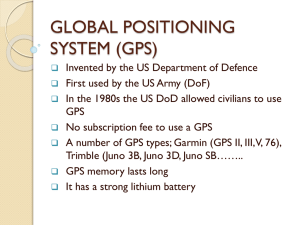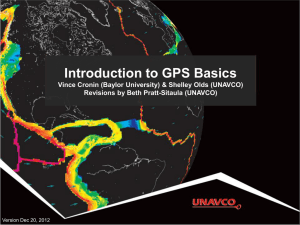The Next Generation of Amateur Beacons
advertisement
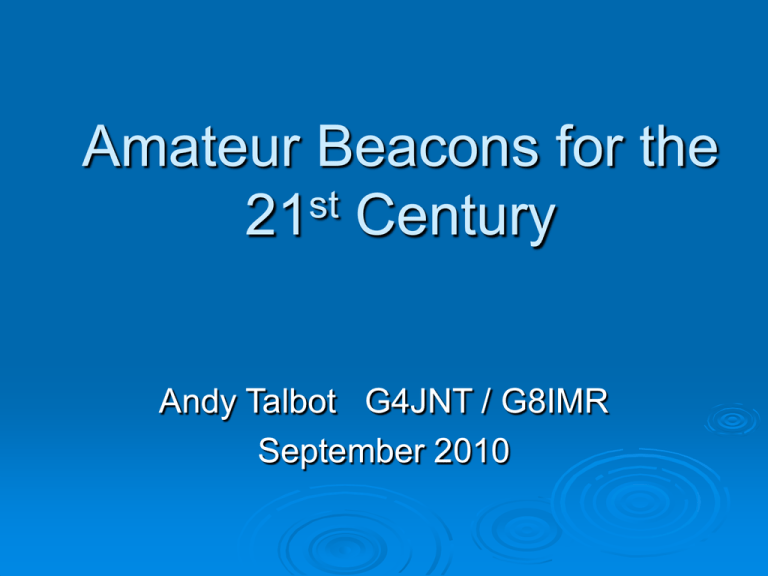
Amateur Beacons for the st 21 Century Andy Talbot G4JNT / G8IMR September 2010 What is a Beacon ? A Transmitter at a Known Location That transmits a prestored message, With Limited Information Content, Continuously, or Periodically, On a Known Frequency, For reception by anyone What do we want beacons for ? Band openings, but there’s nobody on! Is there anybody out there, is the band dead? I can’t hear anyone, is it working? Frequency Calibration Antenna and Bearing setup What do we have now HF Beacons IARU Beacon chain 14 - 28MHz, Five Frequencies CW and Power Stepped Carrier – 10 seconds Time Sequenced • Poor frequency stability / accuracy IBP Chain Call 4U1UN U- Nations VE8AT Canada W6WX United States KH6WOHawaii ZL6B New Zealand VK6RBPAustralia JA2IGY Japan RR9O Russia VR2B Hong Kong 4S7B Sri Lanka ZS6DN South Africa 5Z4B Kenya 4X6TU Israel OH2B Finland CS3B Madeira LU4AA Argentina OA4B Peru YV5B Venezuela Location 14.100 18.110 21.150 24.930 28.200 Operator 00:00 00:10 00:20 00:30 00:40 00:50 01:00 01:10 01:20 01:30 01:40 01:50 02:00 02:10 02:20 02:30 02:40 02:50 00:10 00:20 00:30 OFF 00:50 01:00 01:10 01:20 01:30 01:40 01:50 02:00 02:10 02:20 02:30 02:40 02:50 00:00 00:20 00:30 00:40 00:50 01:00 01:10 01:20 01:30 01:40 01:50 02:00 02:10 02:20 02:30 02:40 02:50 00:00 00:10 00:30 00:40 00:50 OFF 01:10 01:20 01:30 01:40 01:50 02:00 02:10 02:20 02:30 02:40 02:50 00:00 00:10 00:20 00:40 00:50 01:00 01:10 01:20 01:30 01:40 01:50 02:00 02:10 02:20 02:30 02:40 02:50 00:00 00:10 00:20 00:30 UNRC RAC/NARC NCDXF NOARG, HARC NZART WIA JARL SRR CRSA, HARTS RSSL ZS6DN ARSK IARC SRAL ARRM RCA RCP RCV What do we have now Other HF Beacons Majority on 28MHz for Propagation alerts 5.29MHz for propagation tests Generally banned below 7MHz Apart from occasional specials VHF Hundreds around the world Simple crystal control, freq +/- tens of ppm. Carrier and CW – callsign and locator Improvements Design for Automatic Monitoing using PC / Soundcards Narrow band Want good frequency stability Frequency Reuse Time sequenced – helps QRM and regulatory issues Simplifies auto-monitoring of multiple beacons • No Retuning Next Generation HF Frequency Aim for better than 10-7 at HF (+/-1 Hz) TCXO or Ovened oscillator Minimise Stability frequency clutter Time sequence - like the IARU chain Change the rules to allow beacons below 7MHz Let technolgy reduce the QRM by • Precisely timed transmissions • Single frequency on each band, worldwide ? WSPR ?? • Already Well Established • Reporting Website in place • Automated reports How About a Network of WSPR Beacons ? Data Modes PSK31 or RTTY could carry information Propagation state, band openings Site telemetry Unique time signature confirms reception Time / Temperature / Pressure / ??? Status of other beacons QSL / Report Checking Next Generation VHF Decent Ovened crystal or GPS locked Look for 10-9 accuracy (sub Hz) for auto search Add Frequency accuracy weak signal data modes JT65 Extended period of coherent carrier for very narrow band integration PSK reversals for time-of-flight mewasurement Microwave Beacons Often Used when / Portable for : Frequency calibration Dish and Bearing setup Propagation Monitoring Microwave Beacons Frequency accuracy even more important as They are often used for calibration need a lot more μWave beacons to ensure everyone can hear at least one on each band We Personal beacons Attended or unattended Licensing easier at microwaves What is needed – where shall we go? Some Examples of next-generation beacons are already out there…. The 5MHz beacon chain GB3RAL GB3WES GB3ORK transmit in sequence. • 1 minute every 15 GPS timed Power steps over 54dB for audible S/N estimation TCXO frequency control (few Hz) The system was designed for automatic logging (G3PLX software) Cover a complete sunspot cycle 5MHz Automatic Propagation Monitor GB3SSS 1.96MHz / 3.6MHz Temporary beacon for winter transatlantic propagation tests from Poldhu 1 Nov to end Jan 2007 Year later on 3.6MHz Sequence similar to the 5MHz beacons 1 / 15 minutes, power steps, carrier message – decoded in Canada All waveforms generated in DDS chip PSK31 GB3VHF 144.43MHz Wrotham, Kent GPS Controlled frequency and time JT65, CW, 1pps PSK Two minute repeat cycle Generic beacon driver concept Up to 16 thirty second time slots can each be allocated to different modes GB3VHF GPS Disciplined Reference (12.8MHz) GPS Module PIC Controller DDS Source GB3RAL VHF Chain 40.05 50.05 60.05, 70.05MHz Phase coherent from GPS Locked master reference JT65, CW, 1pps PSK Two minute repeat cycle Bell Hill Microwave Beacons Single site cluster of seven beacons for 2.3 to 47GHz and telemetry Tx on 70MHz Evolutionary upgrades in capability GB3SCS GB3SCF GB3SCF GB3SCX GB3SCK G8BKE/P G4JNT/P 2320.90503MHz JT4g 3400.905000 MHz RTTY 5760.905006MHz QRSS 10368.9050068 MHz JT4g 24048.905 MHz (CW only) 47.088905 GHz (CW only) 70.031MHz PSK31 Telemetry GPS Locked GPS Locked GPS Locked GPS Locked OCXO OCXO TCXO Bell Hill Microwave Beacons Beacon Hardware Several parts already exist in current designs Driver / oscillator (but freq may need stabilising) Power Amplifier (+ filters) Antenna But several new modules will be needed Agile Frequency Source Controller / keyer Timing – eg GPS Power Amplifier Power For low duty cycle time sequenced, simple class A or A/B MOSFET design is ideal Broadband – so useable over multiple bands (beware filtering needs) High Steps, PSK31 etc need a linear PA duty cycle with no linear modes Class C design is better suited. Particularly at VHF / UHF Frequency Multiplication Frequency Source Crystal oscillator Single frequency, no data modes Poor Frequency Stability Use oven or clip-on heater DDS Directly useable at HF and low VHF • Spurii need cleaning up for higher frequencies • GB3VHF - additional crystal filter • μWave beacons, lock crystal oscillator to DDS O/P Direct generation of most data modes Clock from standard frequency reference (10MHz) DDS Sources Older AD9850 / 9851 AD9852 / 9854 Up to 30MHz directly. FM / Phase modulation, But no AM capability Small and simple to use 32 bit frequency register ~ 10-9 freq setting Internal x6 PLL for clock Up to 90MHz directly Amplitude / phase / frequency changed in μs 48 Bit - 10-14 Frequency setting X4 – X20 Internal clock PLL Even Faster devices eg. AD9950 Controller Simple CW Keyer Tiny PIC More Advanced Controller Microcontroller eg. PIC ‘Workhorse’ 16F628 has enough power for most controller tasks Reprogramme a Direct Digital Synthesizer in real time to generate data modes AD9852 100μs to reprogramme (serial) PSK31, JT65, FSK441 and RTTY demonstrated already. Accept external data / telemetry inputs Timestamp the transmission with a unique code Verifies correct reception at any given date / time. Only the keeper knows the hashing key. Simple to do in a PIC from the GPS data stream Verifiable QSL – could this count as a one-way QSO !!!! Alphanumeric code with pronounceable triads :- 1800 1805 1810 1815 JYC PEF MEB TOD 1801 1806 1811 1816 PUF HAR TAD ZUC 1802 1807 1812 1817 KIC CEG CAB FYF 1803 1808 1813 1818 FOF LUD HED NAC 1804 1809 1814 1819 WAC RYG MIB WEF May also have to send the minutes digit for correct time logging. Repeater Beacons Add a receiver and data decoding Decode your callsign sent to it Reply with acknowledgement and report Who will be the first ? Reverse Beacon Instead of a Transmitter Just a receiver with Internet Connection You transmit to it It reports to the web site, shows spectrum There Ideal for antenna / transmitter tests OR, are a number of these at LF, phone up, transmit and listen (Modest) premium rate phone number could finance it And talking of Finance..... Beacons Site Cost Money Rental (Bell Hill £500 per year) Electricity (Bell Hill 200 Watts 24/7) Operators travelling Costs for maintenance And, of course, the hardware itself http://www.scrbg.org/donate/ Hamfest Stand Questions ?
